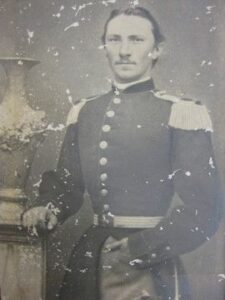Giovanni Buzzacchi

From Medole attraverso i tempi [Medole through the times],Brigoni Francesco (1978), Medole, pages 48-49:
A fervent patriot, he interrupted his studies to enlist as a Garibaldian volunteer in 1860 heroic expedition of “I Mille” [The Thousand].
Throughout the campaign, this Garibaldian from Medole stood out as the most valiant in the harshest clashes fought in Calatafimi, Palermo and Milazzo, garnering praise and honours everywhere.
Back at home, he resumed his studies at the University of Pavia.
He got his Medical degree with honours, then he joined Garibaldi’s troops again, at the express invitation of Garibaldi himself, who chose him as his faithful doctor and to whom he entrusted some important surgical and coordination tasks, in emergencies, in the aid of the wounded of 1866 war campaign in Trentino.
He was among the first who helped the heroic Mantuan Colonel Giovanni Chiassi, who died in Bezzecca as a consequence of the serious wounds he had suffered in battle.
After the war he continued his promising medical career. A skilful specialist, he applied his talent to the surgical sciences and for 23 years he was the head physician of the Ospedale Civile (public hospital) in Mantua, where he had the privilege of introducing a new method of sterilization and prevention of infections in his operations.
The fame of this avant-garde surgeon from Medole soon reached its peak, and his death, which occurred in Medole, was blatantly announced and spread the following day by the Gazzetta di Mantova (Mantua Gazzette) and by the most important newspapers in Lombardy.
When his body was exhumed, a photograph of Garibaldi was found next to his mortal remains along with the funeral announcement: Buzzacchi had proudly kept the photograph with him on his death.
A street in Medole was named after him and a memorial stone was placed on the facade of the building in Via San Martino – Saint Martin street – (now property of the Porrini family), which had been his house and residence and where he died on 21 st January 1900 .
Pietro Scaratti

From Medole attraverso i tempi [Medole through the times],Brigoni Francesco (1978), Medole, pages 50-51:
Pietro Scaratti is another heroic Garibaldian from Medole: he took part in the legendary expedition of the “Mille” (the Thousand) alongside the “hero of the two worlds”.
In 1859, at the age of 18, Pietro Scaratti, filled with ardent patriotic faith, left the University of Pavia where he had been attending the course of Physics and Mathematics, to flee with Garibaldi and join the Cacciatori delle Alpi (Hunters of the Alps) fighting in Varese, San Fermo and Tre Ponti.
In 1860 he enlisted with Garibaldi’s volunteers to conquer the Regno delle due Sicilie (Kingdom of the two Sicilies).
Setting sail from Quarto, young dynamic Scaratti stood out as most valiant even before landing. Once off the Sicilian shore, he was chosen with a group of bold, daring ones sent to explore the coast aboard a modest lifeboat.
They went ashore on the night of 10 to 11 May and, by means of light signals, prepared the successful landing in Marsala.
Pietro Scaratti distinguished himself in the course of the military advance, which earned him a promotion for bravery in the field, and was entrusted with the leadership of a group of Sicilian volunteers – called “Picciotti” -, who followed him up to the final battle of Volturno.
After this triumphant exploit, he completed his studies, then joined Garibaldi’s troops again to take part in all the campaigns for the union of Italy.
During his time in the army, Pietro Scaratti reached the rank of infantry lieutenant. Attached to the tramway services, he was the author of an in-depth analysis on line railway movement and was entrusted with the delicate task of manager in charge of marshalling and transferring the Piedmontese troops.
Discharged from the army in 1872, he pursued a teaching career, to which he devoted more than thirty years of his life and where he was able to merge his excellent teaching skills with those patriotic ideals that he himself had practised and lived during the most decisive moments of the Italian Risorgimento.
A promoter of charitable institutions, Pietro Scaratti was for many years managing director of the Brescia-Mantua-Ostiglia steam tramway. He encouraged works of social progress and was councillor, alderman and deputy mayor of the municipality of Medole for several terms. He founded the Society of Soldiers on leave and was its honorary president until his death, on 14 th January 1912.
The extensive correspondence found in the family archives, carefully preserved by his niece, Mrs Amietta Scaratti, married to Surveyor Augusto Baguzzi of Asola, includes a wealth of documents in the form of decrees, accolades, patents and medals. His correspondence also mentions illustrious names from the past: Garibaldi, Edmondo De Amicis, deputy Alceo Pastore, the Honourable Enrico Ferri, member of Parliament, and many other well-known personalities of the time.